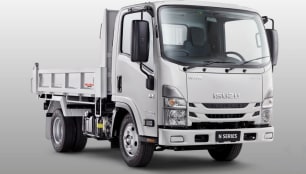Based on the top-shelf Crafter van, the Kampervan then goes on a mission to be both a car and a holiday house.
So, pull up a comfy chair, because there’s a fair bit to discuss here. This isn’t just a tent on wheels, it’s a fully functional tiny home that just happens to be relocatable on a daily basis. As such, the vehicle needs to be able to manage energy, water, gas and waste.
VW’s aim was to elevate the quality standards of the caravan industry to that of the car-making world, as well as address its customers’ main agendas, including storage, the ability to go off-grid and the management of light and ventilation for sleeping.
That utility starts with the walk-through layout where the front seats swivel to form the other half of the dining table seating. From there, the layout runs to a full bathroom, a kitchen and then back again to a fixed queen-size bed.
The bathroom combines a shower and a lavatory with a cassette system for black-water storage and disposal.
The kitchen features a 90-litre fridge with a freezer drawer that is accessible form both inside and outside the vehicle. There’s a dual gas-hob and a 9.0kg gas bottle stored in the rear compartment (under the bed, but accessed from outside) that also includes a huge slide-out drawer for an extra fridge or whatever else needs to be carted around.
There’s also a sink with a mixer tap and the vehicle carries 120 litres of fresh water, not to mention gas-powered on-demand hot water.
A wind-out awning runs the full length of the van, extending the living space and forming a space for the VW-branded camping table and chairs.
The bedroom includes a pair of swivelling fans for cross-ventilation, USB and 240-volt ports, a swivelling TV and blinds and screens on all windows. The standard air-conditioning system will also run for about seven hours before the vehicle runs out of power.
Speaking of power, the electrical system is a force of nature. Aside from the standard Crafter battery (which remains the start battery and can’t be depleted by the equipment on board) the standard smart-alternator function has been disabled so the engine can help charge the batteries whenever possible.
That power storage array incorporates a 400Ah lithium-ion battery with a 3000-watt inverter to run the 240-volt system even when off-grid. There’s a 60A DC-to-DC charging system and, all up, VW reckons the vehicle can stay off grid for about three days straight based on normal power consumption. A multi-screen control panel tracks power usage and issues alerts when required.
So, what’s missing from the Kampervan? Climate-control air-conditioning for the cabin, mainly (the Crafter starts life as a commercial van, after all). Oh, and beds for the third and fourth passenger. Cue hippy-free-love jokes.
The Kampervan starts at $157,990 for the on-road biased Style model and $165,490 for the All-Terrain version.
As the more off-road capable variant, the All-Terrain gets 16-inch steel wheels with all-terrain tyres, bash plates, a higher ride height and a snorkel.
In either case, the accommodation fittings and fixtures are identical, that sounds pretty steep, but go out and price a full-sized four-wheel drive and a full-sized caravan with a bathroom and then see how it all stacks up.

